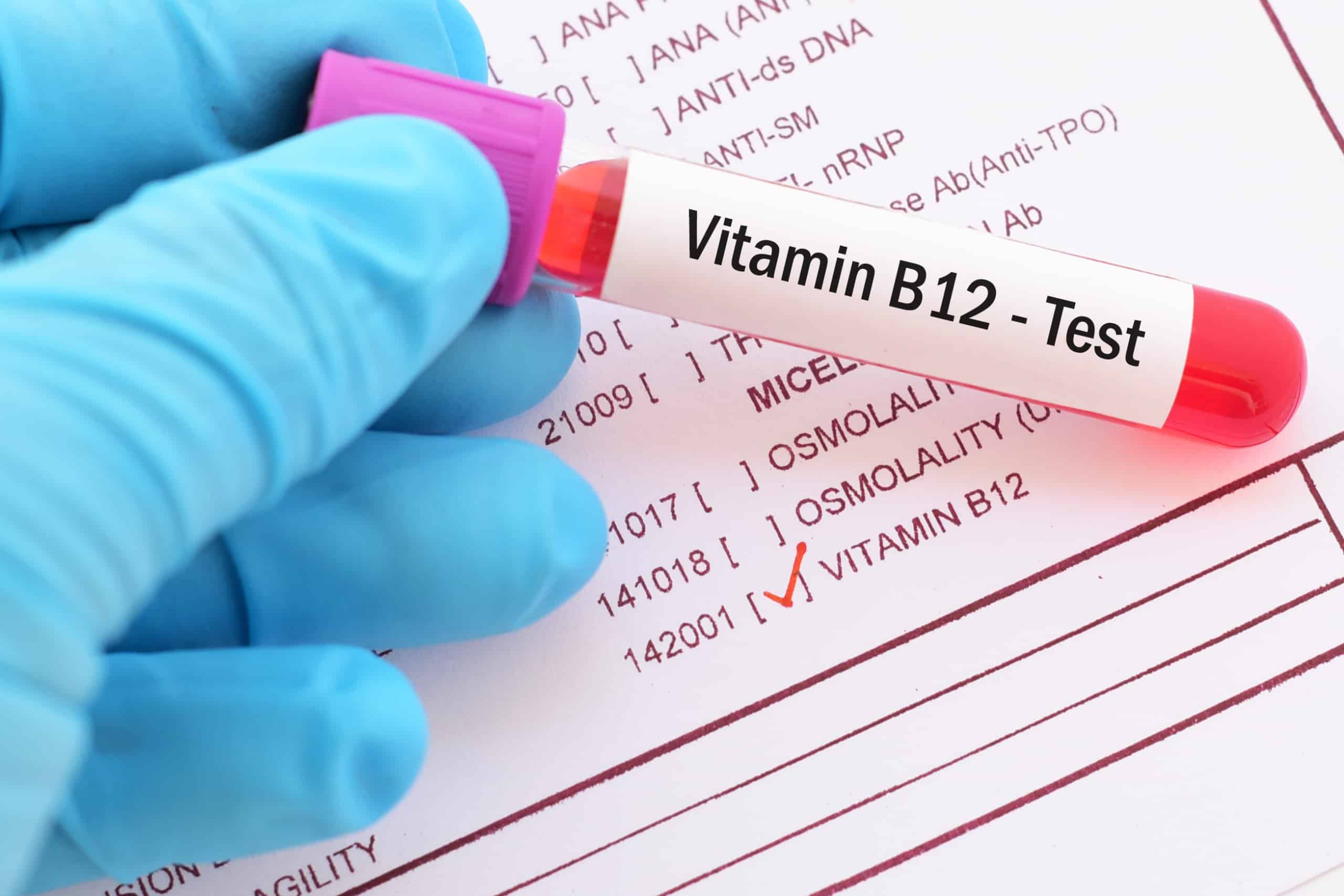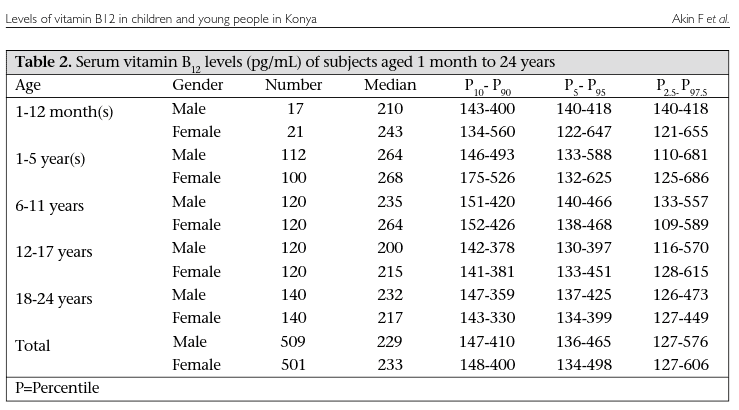Wondering if you have normal B12 levels?
We often hear questions like, “My B12 is 201 — does that mean it’s low?” When we tell them it probably is, they usually bring out the “but it looks okay according to my clinic’s vitamin B12 normal range chart!” Other readers ask for a more specific chart, something that lists normal B12 levels by age or gender. Let’s clear up the confusion.
Normal Doesn’t Mean Optimal
Unfortunately, the regular total-B12 blood level test doesn’t tell us nearly as much as people think it does. This is due to a number of reasons:
- In most countries, the lower vitamin B12 range of what’s considered normal levels is too low (100-250), often missing severe deficiencies. People show signs of B12 deficiency even at higher levels, as deficiencies may begin to appear in the cerebrospinal fluid below 550. This is why some professionals now treat anybody with levels lower than 500 with B12 injections. While 200 is often accepted as a low normal value that doesn’t require intervention, some clinics have updated their suggested range to 500-550, considering anything less to be dangerous.
- The total-B12 blood test isn’t reliable. It measures the total amount of B12 in the blood but doesn’t distinguish between active and inactive forms. Inactive analogues of B12 (transcobalamin I and III) may represent as much as 90% of your blood levels. If a significant amount of your B12 is inactive, the test might still show normal vitamin B12 levels. Depending on the population, 30-50% of patients with low active-B12 levels will have ‘normal’ total-B12 levels of 150-300.
- The total-B12 blood test doesn’t record what’s happening at the cellular level. Blood levels alone aren’t enough; we want to understand what’s going on inside the cells. Therefore, an assessment of B12 status by serum B12 levels is insufficient.
In short, you can’t rely on the regular serum B12 level test to tell you the whole story. You can only use it as an indicator. Now, let’s show some actual charts.

Normal Vitamin B12 Levels
In most countries, the observed normal values of vitamin B12 – in both children and adults, males and females – are anywhere from 100 to 1400pg/ml. These observed levels vary from one culture to another. Dr. Ralph Carmel reported that blacks have significantly higher B12 levels (especially active-B12 levels) than whites do, while the lowest levels were observed in India, Africa, and Pakistan. It can be because of racial differences in B12 metabolism, or in societal factors – most obviously nutrition. Probably both.
As an example, let’s take Konya, Turkey, and compare it to other places. We’ll examine kids and teenagers, since these are groups for which we have plenty of data.
Normal B12 Levels By Age – Konya, Turkey
Let’s take a look at this study from Turkey, which measures vitamin B12 levels by age (0 to 24 years old). Pay particular attention to the median levels (the Median column), and the full range of the 2.5-97.5 percentile group (the rightmost column).
This rightmost column excludes the lowest and highest 2.5% of values, covering 95% of the population. This range is broad enough to include most people, while excluding only the most extreme outliers, which might be due to rare conditions or errors. In medical contexts, this range is often the standard for what is considered “normal.”

As you can see, the combined normal B12 level range of children and teenagers in Konya is 109-686. Now, compare it to children from other places in the world:

Although American teenagers have similar normal B12 levels (in females and males) to Turkish teenagers in Konya, there are big differences among other countries. So, if some clinics have raised their minimum suggested B12 levels to 500-550, does that mean most children in some countries are B12 deficient? Not necessarily. Many people with levels of 300-400 are perfectly healthy. The threshold increase is precautionary.
The Optimal B12 Levels Chart
Since B12 blood levels don’t represent true B12 status well enough, many suffer from a deficiency even if their level falls within the normal B12 levels chart. In their book Could It Be B12?, Sally Pacholok and Jeffrey Stuart suggest different optimal B12 levels:
| B12 Status | B12 Levels (pg/ml) |
|---|---|
| Deficiency | < 550 |
| Normal | > 550 |
| Healthy nervous system & disease prevention in the elderly | > 1000 |
To quote Sally and Jeffrey:
At this time, we believe normal serum B12 levels should be greater than 550 pg/ml. For brain and nervous system health and prevention of disease in older adults, serum B12 levels should be maintained near or above 1000 pg/ml.
The tragedy is with people who are symptomatic but fall within the low vitamin B12 normal range (200-500). This is the gray zone — despite showing clinical signs of B12 deficiency, these people are often neither tested nor treated because their levels are considered within the acceptable B12 level range. This can lead to delayed diagnosis (if it happens at all) and an increased risk of neurological damage.
Therefore, don’t rely on blood tests alone.
Note: If you know you’re deficient and you want to quickly replenish your B12 stores, you can now order a B12 injection vial here. We finally made it available 🙂
How to Check For Healthy B12 Levels?
So, if normal B12 levels for adults and children both don’t mean much, then how do you really test for B12 deficiency? There are three ways:
Methylmalonic Acid (MMA)
Vitamin B12 helps converting methylmalonyl-CoA, one of the forms of MMA, into succinyl-CoA. When you’re deficient in B12, MMA levels increase in both your blood and urine. You may be able to find an MMA test in hospitals or private labs.
If you can’t find one, you can order a urinary MMA test from Dr. Eric Norman, founder of the test. The uMMA test is even better than the serum MMA test, because B12 deficiency patients with neurological damage excrete significantly more uMMA than those without damage. Therefore, uMMA tests can predict one’s path toward permanent neurological impairments. The test has a whopping 99% accuracy, making it confirmatory.
Keep in mind, if you have kidney disease you may get falsely high results from the serum MMA test, or falsely low results from the uMMA test. This happens because the kidneys are responsible for excreting MMA in the urine, and if they aren’t functioning properly, MMA can accumulate in your blood. Serum MMA levels may also be elevated in patients with thyroid disease, bacterial overgrowth in the small intestine, pregnant women, or infants with a rare genetic disorder called methylmalonic acidemia.
However, if your uMMA levels are high, it’s highly likely that you have a B12 deficiency. This is about as confirmatory as any B12 deficiency test can be.
Holotranscobalamin (HoloTC)
Another useful test is the holotranscobalamin (holoTC) test, which only records the active form of B12 in the blood. Low levels may indicate B12 depletion at the cellular level. There are often large gaps between total and active B12 levels in the blood.
Homocysteine
Another test to help assess true B12 status is homocysteine (tHcy). The body uses methyl B12 as a co-factor to convert homocysteine back into methionine, and if you have normal B12 levels but high homocysteine, this may be due to a B12 deficiency. Although, high tHcy could also be the result of low B6, folate, renal failure, or hypothyroidism.
The above tests can help you get a correct diagnosis. We also recommend to test for folate and ferritin (iron storage), and do a full blood count. Vitamin B12 and folate need each other, and optimal levels of iron are just as important as optimal B12 levels.
Rely On Symptoms
To quote NEQAS:
In the event of any discordance between clinical findings of B12 deficiency and a normal B12 laboratory result, then treatment should not be delayed. Clinical findings might include possible pernicious anaemia or neuropathy including subacute combined degeneration of the cord. We recommend storing serum for further analysis including MMA, or holotranscobalamin and intrinsic factor antibody analysis, and treating the patient immediately with parenteral B12 treatment.
The United Kingdom National Quality Assessment Scheme for Haematinic Assays
If you suspect you may be suffering from B12 deficiency, then take action now. Wait too long, and permanent neurological damage can take place. If you’re unsure, disregard blood vitamin B12 levels entirely and go by symptoms alone, because the risk of delayed treatment is too high. And remember, you can’t overdose on B12.
The earlier you begin treatment, the more likely you are to avoid damage and completely reverse symptoms. However, there’s a narrow window of opportunity for effective intervention, especially for those with neurological symptoms. Don’t miss it.
When you suffer from B12 deficiency, the myelin sheath around your nerves is being stripped off. If you show any symptoms, especially neurological, then start injecting methyl B12. These shots are the best way to rapidly replenish your stores. Do it for at least three months, because this is the life-cycle of red blood cells. Only after 90 days will you have all your bad cells expired and replaced by healthy ones.
Then, see how you’re feeling.
Best of luck.

